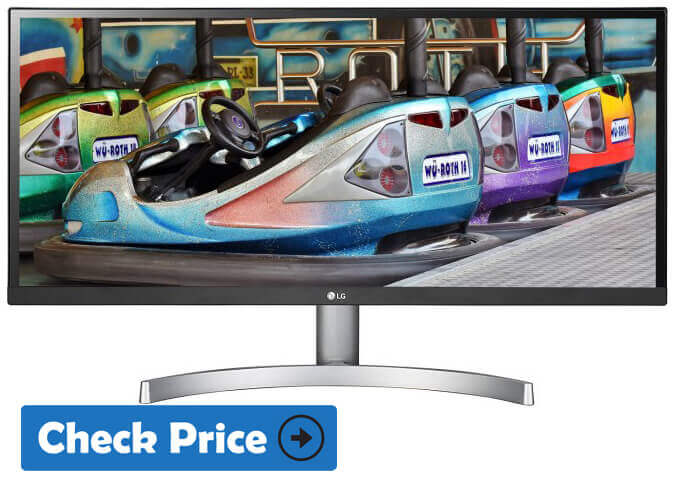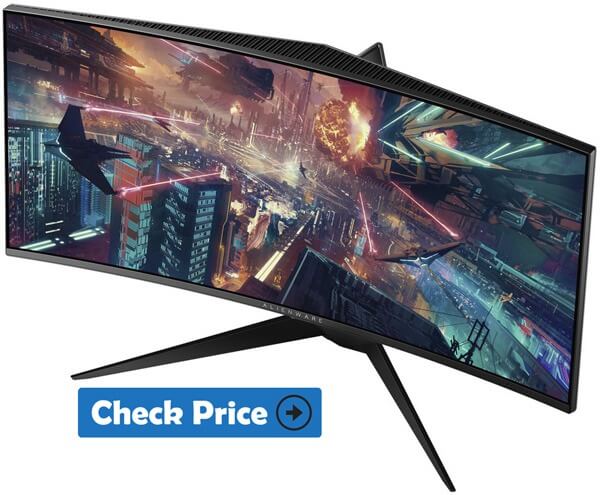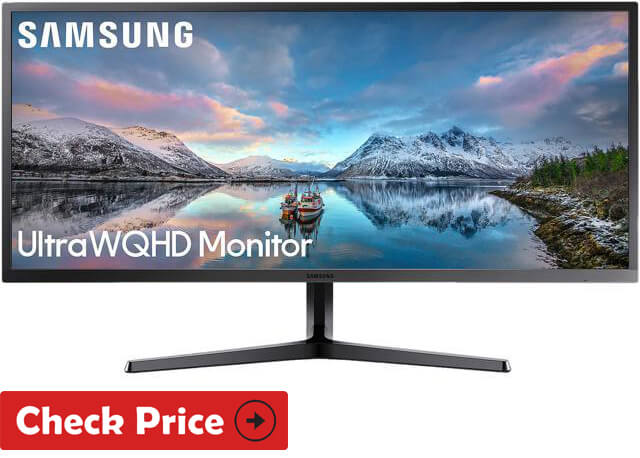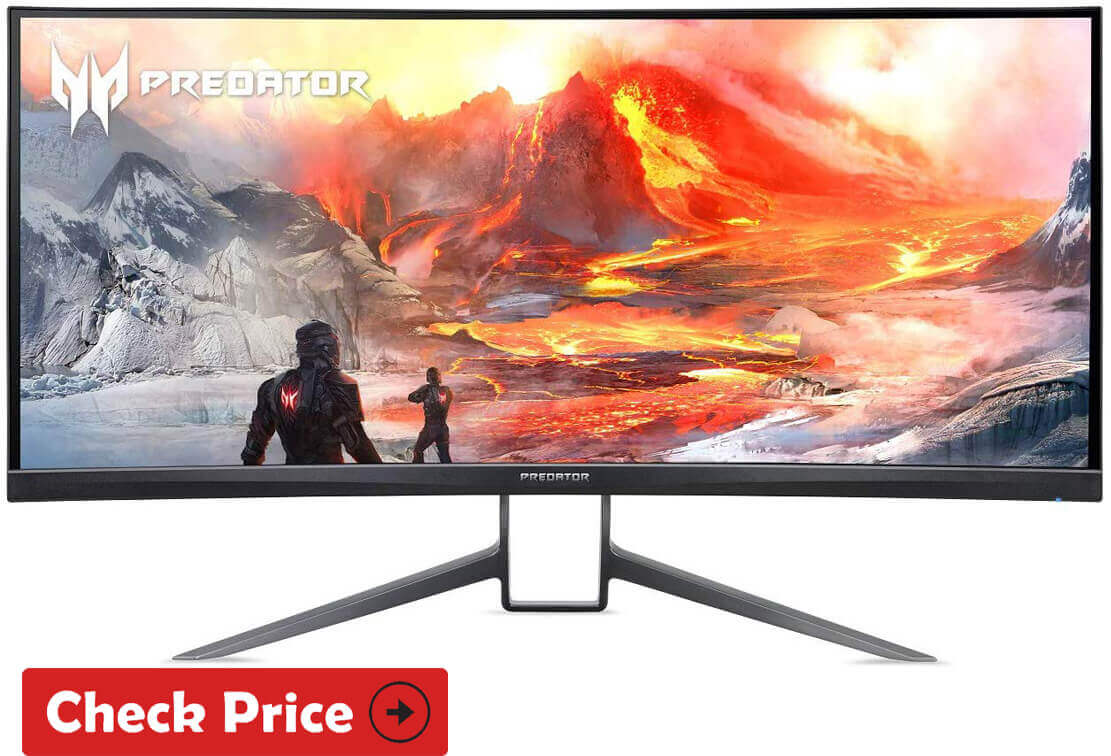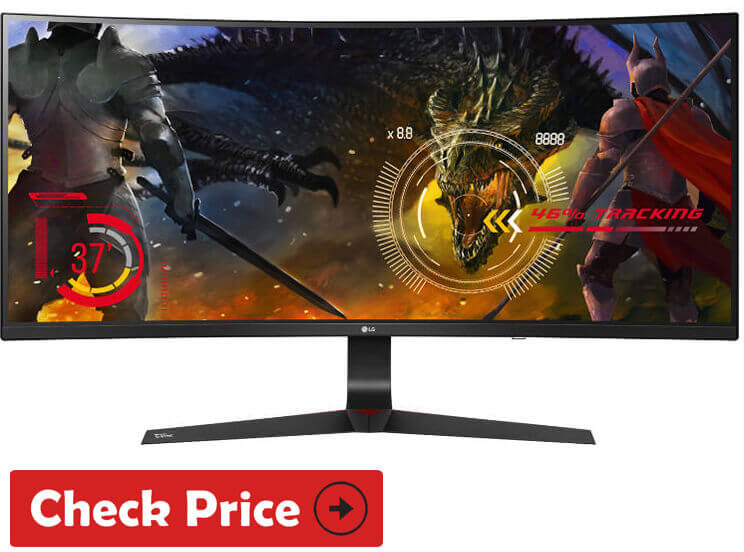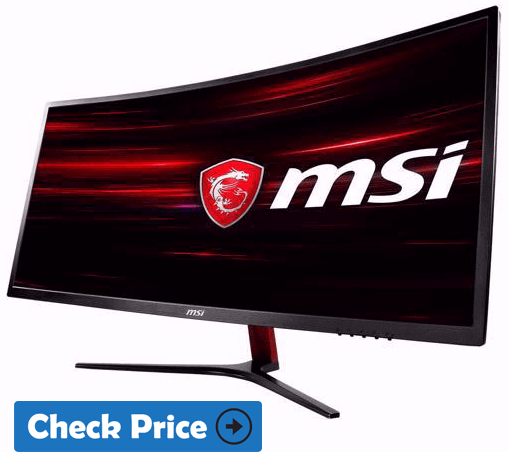In an era where monitors are always getting bigger and thinner, we now have a plethora of models to choose from. Choosing the Best Budget Ultrawide Monitor can be a bit difficult, however, as you should also be aware of other features that are more technical in nature.
Knowing what to look for and what makes a monitor right for you will save you from having to replace it very quickly. When you buy a normal monitor like the standard monitors that are used in offices, there is not much to think about. However, when you buy an ultra-wide monitor, many factors come into play.
It is true that we always choose the best products available on the market. However, what makes a perfect monitor for someone else will not necessarily make the best monitor for you. To help you make an informed decision, here are the main things you should keep in mind when you are in the market for a new ultra-wide monitor.
Best Budget Ultrawide Monitor
Table of Contents
Since the late 2000s, the 16: 9 format has been adopted worldwide by screen manufacturers, which means that most of the monitors available on the market all have the same aspect ratio. So when it comes to choosing a new screen, consumers are mainly concerned with its size, type of screen, resolution or refresh rate – but not much with the format. However, if the (pre) historic format of 4: 3 TV is definitely dead and buried, the 21: 9 format (or ultrawide as it is often called) begins to gain popularity!
And for good reason: most people who have enjoyed the pleasure of playing or watching a movie on a 21: 9 screen agree that this new format is a real revolution. But switching to an ultrawide screen represents a significant investment. Do you use it? Is it really worth it? And if so, what are the criteria to consider when choosing the model that best suits your needs? You will find all your answers and much more in this guide!
Best Budget Ultrawide Monitor | Comparison Table 2025
Top Quality | Great Price | 5-Stars Picks
| Gaming Monitor | Screen Size (Inches) | LCD Type/Panel | Refresh Rate | Response Time | Price $$ |
|---|---|---|---|---|---|
| LG 34GK950F (Editor's Choice) | 34 | IPS | 60Hz | 4ms | |
| Dell Alienware AW3418DW | 35 | VA | 60Hz | 4ms | |
| Samsung S34J55W | 34 | IPS | 144Hz | 1ms | |
| Acer X35 | 34 | VA | 100Hz | 8 ms | |
| LG 34UC89G | 49 | VA | 144Hz | 1ms | |
| MSI MAG341CQ | 34.1 | IPS | 120Hz | 4ms | |
| Philips 276E8VJSB | 35 | VA | 120Hz | 4ms | |
| Sceptre C305B-200UN | 34 | IPS | 60Hz | 5ms |
Best Budget Ultrawide Monitor | 2025 Products Overview
1. LG 29WK600 Best Budget Ultrawide Monitor (Editor’s Choice)
Key Specifications
About:
The LG 29WK600 has an IPS panel with a 99% sRGB range to ensure accurate, consistent, and vivid color reproduction suitable for novice designers and photographers.
In addition, its resolution 2560 x 1080 provides a rich screen and crisp detail thanks to a solid pixel density of 96 PPI (pixels per inch).
Other panel-related features include a static contrast ratio of 1000:1, a peak brightness of 300 nits, and a wide viewing angle of 178 degrees, all of which are the standard for IPS screens in this price range.
The monitor also supports HDR (High Dynamic Range), but uses only software emulation because there is no correct gamut, brightness, or contrast for outstanding image enhancement of HDR content.
Basically, enabling HDR on compatible content only fades the image, but in rare cases, it may look a little better. This type of HDR support does not actually raise the price of the monitor, so you can ignore it.
Also Read: Best Portable Monitor For Laptop
Image Quality & Performance:
Its resolution 2560 x 1080 provides a rich screen and crisp detail thanks to a solid pixel density of 96 PPI (pixels per inch).
Other panel-related features include a static contrast ratio of 1000:1, a peak brightness of 300 nits, and a wide viewing angle of 178 degrees, all of which are the standard for IPS screens in this price range.
The monitor also supports HDR (High Dynamic Range), but uses only software emulation because there is no correct gamut, brightness, or contrast for outstanding image enhancement of HDR content.
Basically, enabling HDR on compatible content only fades the image, but in rare cases, it may look a little better. This type of HDR support does not actually raise the price of the monitor, so you can ignore it.
Design & Connectivity:
The design of the LG 29WK600 is tilt-only but is compatible with VESA mounting (100 x 100 mm). Connection options include two HDMI 2.0 ports, DisplayPort 1.2, a headphone jack, and two MaxxAudio 5W built-in speakers.
The monitor is 29 diagonal but is as large as the 23″16:9 screen because it is wider than a regular 16:9 widescreen monitor. At first, you might be a little annoying, especially if you’re used to big monitors, you’ll soon fall in love with the extra-wide ratio and all the extra horizontal space.
Features:
With AMR FreeSync Variable Refresh Rate (VRR) technology, you can enjoy the gaming experience without screen break, sound, or additional input delay when using AMD or NVIDIA-compatible graphics cards (GTX 10 series and later).
The VRR range of the LG 29WK600 is 40-75 Hz/FPS (frames per second). Therefore, as long as the FPS rate is inside, smooth performance in video games is guaranteed.
Other useful features include on-screen controls (to adjust OSD settings for desktop applications), screen sharing (splitting the desktop into different layouts to facilitate multitasking), black stabilizers (for dark games that improve visibility), dynamic synchronization of actions (minimization of input lag), custom crosshairs, image presets (FPS, RTS, etc.).
Finally, the monitor responds at a response speed of 5 milliseconds. This is fast enough to eliminate the noticeable leakage of objects moving rapidly in 75 Hz video games on IPS panels.
[youtube https://www.youtube.com/watch?v=OHIypw7XvTc]Also Read: Best Monitor for Programming & Coding
- Best budget price
- Decent pixel density
- Vivid colors and wide viewing angles
- Many features including FreeSync
- Tilt-only design
- doesn’t have HDR support
2. Dell Alienware AW3418DW
Key Specifications
About:
The Dell Alienware AW3418DW has an immersive and responsive gaming experience with almost every box checked.
It features a huge 34-inch curved screen with rich colors and high resolution to achieve stunning image quality and 120Hz refresh rate, low input delay, fast response time, NVIDIA G - SYNC for perfect performance.
Also Read: Best Portable Monitor For Gaming
Image Quality & Performance:
The Dell AW3418DW is based on an LG IPS panel with a maximum brightness of 300 nits, a static contrast ratio of 1000:1, and an sRGB gamut of more than 99%.
Currently, these specifications are a little lower than the specifications of entry-level HDR displays with a peak brightness of at least 400 nit and 90% DCI-P3 gamut, but nevertheless, the AW3418DW is vibrant, It's sharp.
Other panel specifications include a 178-degree wide viewing angle, true 8-bit color depth, and a UWQHD 3440 x 1440 resolution that provides a high pixel density of 109 pixels per inch.
Overall, the Alienware AW3418DW provides vibrant, accurate, and consistent colors while balancing screen space with detailed clarity.
IPS monitors can be used for professional installations, but Dell Alienware AW3418DW monitors are factory calibrated and have no gamma settings, so a calibration device is required for quality. The best image.
The Dell Alienware AW3418DW input offset performs well and only takes 4 milliseconds.
The response speed of 4 ms then removes most ghosts and motion blur from the slightly visible artifact-only fast-moving object. The higher the frame rate, the fewer ghosts.
There are far fewer ghosts than the ultra-wide VA panel counterparts. Va monitors are darker in black due to high contrast, but the improved response time for IPS monitors allows for much more fun, fast gameplay.
The on-screen display menu has a response time setting with three options (usually fast and ultra-fast). It turns out that "normal" works better because "fast" and "ultrafast" generate overshoot or inverted ghost images.
The 100 Hz refresh rate significantly improves motion clarity and further reduces the input lag. This makes the game more fun, especially in the fast fps and racing genre.
Bleeding from IPS glow and backlight is minimal and appears only in extreme scenarios. There are no dead pixels or similar defects. In addition, the screen has a filter for low-blue light that is not flickered and is harmful.
Finally, the 21:9 aspect ratio provides a wider perspective and a more engaging gaming experience. This is because the game supports the ultra-wide resolution. You can check out all the games supporting 21:9 here.
Design & Connectivity:
The design of the Dell Alienware AW3418DW may not be attractive to everyone, but more importantly, the monitor is sturdy with a metal stand and matte chassis.
In addition, the top and sides of the monitor have ultra-thin bezels that provide a cinematic viewing experience in addition to the 1900R curvature. The 100 x 100mm model allows you to tilt, rotate, and lift the screen up to 130mm.
The connection consists of a single HDMI 1.4 port and a DisplayPort 1.2 port. Only DP ports support 3440x1440 and G-SYNC up to 120 Hz. Other ports include audio output, headphone jack, and quad USB 3.0 hub (one port for fast charging).
Also Read: Best Console Gaming Monitor
Features:
To overclock the display, go to the OSD menu and set the overclocking parameters to 105 Hz, 110 Hz, 115 Hz or 120 Hz. Responsive and faster pixel transitions even at 110Hz.
The OSD menu has four buttons placed below the bottom frame. Although not listed on the menu, these buttons can be used as keyboard shortcuts for shortcuts that can be customized and assigned in the OSD Customization settings.
Standard settings such as brightness, contrast, and color temperature are available, but as already mentioned, there are no gamma parameters.
Game features include "Dark Stabilizer" to increase visibility in dark areas of video games, "Enhanced Game Mode" consisting of on-screen timers and tracking finally, FPS, RTS, Pre-calibrated image presets, including RPG and three customizable profiles.
The Dell Alienware AW3418DW also features AlienFX RGB lighting technology with four individually adjustable zones, including the back of the monitor, stand, bottom frame, and power button.
Finally, the monitor supports NVIDIA G-SYNC technology, which allows you to change the screen refresh rate depending on the GPU when connected to a compatible NVIDIA card.
As a result, you get a variable refresh rate that eliminates screen breakage and sound without adding an input lug. The dynamic refresh rate range is 30 Hz to 100 Hz or 30 Hz to 120 Hz when overclocking the monitor.
It is also important to note that the Dell Alienware AW3418DW does not have NVIDIA ULMB (Ultra Low Motion Blur) backlight technology, which is often associated with NVIDIA G-SYNC.
Also Read: Best Monitor having Resolution of 1440p
- Immersive viewing experience
- Impressive design
- Gorgeous 1440p screen
- Impressive brightness & colors
- Pricey
3. Samsung S34J55W Budget Ultrawide Monitor
Key Specifications
About:
If you need a large, ultra-large 34-inch monitor with crisp image quality and a lot of screen space, the Samsung S34J55W is the most cost-effective screen.
Image Quality & Performance:
Based on VA panels with a contrast ratio of more than 3000:1, the Samsung S34J55W ultra-wide monitor provides true black with crisp detail in image shadows and highlights.
The colors are not as vivid as the colors of the IPS model, but they are still vivid and beautiful. In addition, adding a 3440x1440 screen resolution will give you an incredibly immersive image quality at that price.
Currently, the specified 4 ms response speed of the Samsung S34J55W is faster than the 5 ms speed of the LG 29WK600 on paper, but in reality, it is a different story.
The VA panel screen is a dark black tone, so dark pixels take a long time to change to other colors. This creates visible dirt on objects that move rapidly if they contain dark pixels.
The Samsung S34J55W has a refresh rate of only 75 Hz, so pixels shift to other colors primarily in time, so there is no noticeable leakage. Some ghosts appear in fast-paced games but are acceptable.
Design & Connectivity:
The monitor stand is tiltable only, but the monitor base can be removed and attached to the third-party stand via the VESA 100x100mm model. Note that this monitor is not curved. This is usually the case for a super-large screen of this size.
Connection options include HDMI 2.0, HDMI 1.4, DisplayPort 1.2, and headphone jack. AMD FreeSync is supported in HDMI 2.0 and DisplayPort 1.2 in the range of 48-75 Hz at 3440 x 1440.
Also Read: Best 24-Inch Monitors For Gaming
Features:
The Samsung S34J55W then supports AMD FreeSync in the 48-75 Hz VRR range. Some units of this monitor can also overclock up to 90 Hz to 95 Hz, but the mileage may vary.
Other features include picture-in-picture and picture-by-picture, low-input offset mode, and light sensors that allow you to adjust the brightness of the screen depending on ambient lighting.
- Good value for the price
- High contrast ratio
- AMD FreeSync technology
- The screen is not curved
4. Acer X35 Cheap Ultrawide Gaming Monitor
Key Specifications
About:
If you don't have money problems and want the best, you'll like the long-awaited Acer X35.
Image Quality & Performance:
The Acer X35 features a more traditional 21:9 ultra-wide format and uses a full matrix local dimming solution (FALD) instead of using several dimming zones with backlit backlights with 512 dimming zones that allow for even higher active contrast ratios!
Because there are so many individually controllable dimming areas, the part of the screen that needs to be darkened without affecting the part of the screen that needs to be brighter can be darkened, greatly improving contrast and quality of the image.
Of course, in certain scenarios, the light passes through the gray area and creates a halo/flowering effect. For example, if you have a white cursor on a black background, the cursor has a halo effect.
Fortunately, the local dimming can be turned off in normal use and turned on in video games and videos.
The panel specifications include an amazing peak brightness of 1000 nit (usually 750 nits) for HDR content and 500 nits for SDR, but the contrast ratio is 2500:1 for SDR and 500000:1 for HDR local dimming.
In addition, the Acer X35 supports 10-bit color depth through screening and uses quantum dot technology to provide a wide 90% DCI-P3.
The monitor supports up to 200 Hz, but there is a problem. If a 10-bit color depth is required, it is limited to 144 Hz. To switch to 180Hz and 200 Hz, you must set the color depth to 8 bits or use 4:2:2 chroma subsampling.
This is due to the bandwidth limitations of DisplayPort 1.4, and 3440 x 1440 HDR and 144Hz games are very tough anyway, so it's not a big deal.
Therefore, in a more graphic oriented game, you can enjoy stunning visuals of HDR with a depth of 10 bits and full 4:4:4 (without undersampling). And for competitive titles (most of them are limited to 8-bit color and don't support HDR anyway), you can get the most out of the 200 Hz refresh rate.
Also Read: Best Monitor for Gaming Under 200 USD
Design & Connectivity:
This monitor features a high-end ergonomic design quality of versatile ergonomics including a sharp curvature of 1800R and a height adjustment of up to 130mm, a slope of up to -5 degrees / 35 degrees, and a pivot of +/-45 degrees and compatible with VESA. Connection options include DisplayPort 1.4, HDMI 2.0 (this monitor supports up to 100 Hz with 3440 x 1440), headphone jack, quad USB 3.0 hub, and two built-in 4W speakers.
Features:
The Acer X35 supports NVIDIA G-SYNC Ultimate, thanks to variable overdrive, ensures smooth performance without screen tear, utter sound, additional input delay, and minimal ghosting.
Because it is a VA panel, there are visible traces after all, especially when dark pixels are dominant in the image. Therefore, there are black spots, but to an acceptable degree.
Note that G-SYNC cannot be used with AMD graphics cards.
Other features include Acer RGB Light Sense, Predator GameView (FPS, RTS and similar presets), Aim Point, and Dark Boost.
- Better image quality than other monitors currently available
- Smooth performance with G-SYNC up to 200 Hz
- Expensive
- Not budget ultrawide monitor
5. LG 34UC89G 21:9 Curved UltraWide
Key Specifications
About:
If you need both high screen resolution and 144Hz refresh rate, accurate color and fast response time, the LG 34UC89G is the best ultra-wide monitor for great Image Quality And Smooth Performance.
Image Quality & Performance:
Based on LG's latest Nano-IPS panel, the 34UC89G offers 98% DCI-P3 coverage, 10-bit color depth (8-bit + 2-bit FRC), and a wide range of colors for peak brightness. 400 nits
In addition, the monitor supports VESA DisplayHDR-400 certified HDR, which we determine is too weak for notable HDR viewing experiences like CRG9. But thanks to its wide gamut and decent peak brightness, the image quality of this monitor is excellent. In addition, the benefits of a 144 Hz fast refresh rate and fast response time.
A graphics card with DisplayPort 1.4 is required to achieve 3440x1440 at 144 Hz. Otherwise, it is limited to 120 Hz at 3440 x 1440.
Design & Connectivity:
The LG 34UC89G has a curvature of 1900R, can be tilted -5 degrees / 15 degrees, adjusted at a height of up to 110 mm, can turn +/- 20 degrees to the left and right, and is compatible with support. Vesa.
Connection options include DisplayPort 1.4, two HDMI 2.0 ports, dual USB 3.0 hub, and headphone jack.
Features:
The LG 34UC89G reduces motion blur by 1 ms in addition to common features such as Black Stabilizer, Crosshair, D.A.S, FPS/RTS presets.
It supports AMD FreeSync 2 (48-144 Hz range) and guarantees minimum input latency for HDR games in addition to providing variable refresh rates for compatible cards.
G-SYNC works fine with compatible cards and can be used simultaneously with HDR.
Overall, this monitor has amazing image quality and smooth performance without ghosting or visual impact.
- Nano IPS panel
- Decent contrast
- G-Sync adaptive refresh
- Has no HDR support
- Short warranty
6. MSI MAG341CQ
- Display Size: 24-inch
- Resolution: 1920×1080 FHD
- Panel Type: TN
- Response Rate: 1 ms
- Refresh Rate (Hz): 144Hz
- Sync Technology: G-Sync
- Contrast Ratio: 1000:1
- Aspect Ratio: 21:9
- Brightness 350: cd/m²
- Dimensions (WxDxH): 22.32 x 9.6 x 15.18 in
- Weight: 13.99 lbs
About:
With a small surcharge on the price of the Samsung S34J55W, you can get the MSI MAG341CQ with a refresh rate of 100 Hz, a wider range of colors, and a curved screen.
Image Quality & Performance:
Like the Samsung SJ55W, the MSI MAG341CQ is based on a VA panel with a static contrast ratio of 3000:1 and a resolution of 3440 x 1440, but slightly wider 110% sRGB gamut more realistic colors.
In addition, the 100 Hz refresh rate makes the fast movement of video games much clearer and allows for an immersive gaming experience. Jumping from 75 Hz to 100 Hz is especially noticeable!
In this ultra-wide game monitor, ghost images remain a problem. For casual games, it is acceptable to consider the specs you get at the price. However, if you plan to play fast-paced games in competitive games, Ghost can be a hassle.
Design & Connectivity:
Unfortunately, the monitor has tilt-only support and is not compatible with VESA mounts, but the connection options consist of DVI, HDMI, and DisplayPort inputs. The screen has an aggressive curvature of 1800R for additional immersion.
Also Read: Best Portable Monitor For Macbook Pro
Features:
AMD FreeSync is supported in the 48-100 Hz VRR range, and there is no problem using FreeSync with a compatible NVIDIA card.
Other features include preset image presets (FPS, RTS, film, eye-saver, user), custom crosshairs, overdrive (on/off), and PiP/PbP mode.
There are only two overdrive options, so you need to turn it off at a lower frame rate to prevent pixel overshoot and turn it on at a higher frame rate to reduce ghosting. This can be a problem if the FPS rate drops or fluctuates significantly in the game.
- Smooth refresh rate
- Perfect for gaming
- AMD FreeSync adaptive sync technology
- Curved monitor will give you an immersed experience
7. Philips 276E8VJSB Best 4K Ultrawide Monitor
- Display Size: 24-inch
- Resolution: 1920×1080 FHD
- Panel Type: TN
- Response Rate: 1 ms
- Refresh Rate (Hz): 144Hz
- Sync Technology: G-Sync
- Contrast Ratio: 1000:1
- Aspect Ratio: 21:9
- Brightness 350: cd/m²
- Dimensions (WxDxH): 22.32 x 9.6 x 15.18 in
- Weight: 13.99 lbs
About:
If you are not familiar with the world of 4K, you are willing to know that you can start at an affordable price. The 276E8VJSB 27" Philips monitor is a high quality 4K ultra wide monitor, ideal for high-tech enthusiasts with limited budgets.
Image Quality & Performance:
With its generous 27-inch screen can generate more than 1 billion colors, smoothing details and preventing images from appearing irregularly. If you work or play for a long time, the flicker ingress on the monitor and the blue mode will reduce eye fatigue.
Also Read: Best 4k Monitor For Macbook Pro
Design & Connectivity:
The Display features very narrow borders that minimize distractions and allow maximum display size. Particularly suitable for multi-screen or mosaic configurations such as games, graphic design, and professional applications, a screen with very narrow borders gives the impression of using a single large screen.
Features:
Resolution: These Philips displays use high-performance panels to provide ultraclear 4K UHD (3840 x 2160) resolution images. Whether you're an expert in requiring very detailed images for CAD solutions, using a 3D graphics application, or a financial assistant working in a huge spreadsheet, Philips Display brings images and graphics to life.
Panel Type: The IPS screen uses advanced technology that provides a very wide viewing angle of 178/178 degrees, allowing you to view the screen from almost any angle. Unlike the standard TN screen, the IPS screen provides a very clear image with vivid colors, so photos, movies, web browsing, as well as always color accuracy and constant brightness are required.
Input Lag: Using a small utility called SMTT 2.0 along with sensitive cameras, the latency was analyzed and read more than 30 times to maximize accuracy. This method was used to calculate an input offset of 2.79 ms (1/6 of the 60 Hz frames). Note that the input offset measured here is affected by both the "see" element (pixel reactivity) and the "feel" element (signal delay). It shows very low signal delays and should not even bother sensitive users.
Compatibility: This monitor is also compatible with devices that support Philips MultiView. The system divides the screen into different sections for each entry. This feature allows you to monitor the soccer ball while working in a separate window.
Also Read: Best Gaming Monitor Under Under 100 USD
- UltraClear 4K UHD resolution for increased accuracy (3840×2160)
- IPS LED wide view technology for image and color accuracy
- Narrow border display with transparent appearance
- None
8. Sceptre C305B-200UN Cheap Ultrawide Monitor
Key Specifications
About:
If you need an affordable, high-refresh rate ultra wide display, you can pick the Scepter C305B-200UN.
Image Quality & Performance:
This ultra-wide gaming monitor is based on a VA panel, resulting in a high contrast ratio of 3000:1 compared to the 1000:1 ONK 29WK600 IPS screen. The result is a deeper black, resulting in a right relationship between the darkest and brightest tones.
However, the colors are not so accurate or vivid. The C305B Scepter covers only 90% of the sRGB color space. In addition, the viewing angle is not so wide, but you can see the screen from most angles without changing the color or contrast of the image.
Design & Connectivity:
The Scepter C305B is an ultrawide curved screen (1800R) that adds a bit of depth and immersion to the visual experience. The stand can only be tilted, but the display can be installed using the supplied VESA mounting adapter.
Connection options include DisplayPort 1.2, HDMI 1.4, HDMI 2.0, headphone jack, two built-in 3W speakers, and two red LED strips on the back of the monitor.
Features:
The great thing about the Scepter C305B is that it offers a very low-cost, 200 Hz fast refresh rate, greatly improving the responsiveness and immersion of the gaming experience. Even with only 100 FPS+, video gameplay will be more fun.
Now there's a catch. The per-pixel response time of the VA panel is not as fast as the IPS model, especially when it comes to changing from deep black to other colors. Quick.
The C305B Scepter's response speed is not fast enough to accommodate a high refresh rate of 200 Hz, so it is darker when the FPS rate exceeds 144 FPS, but this is different for each game. Your own sensitivity to other movements. Blur and Ghost.
Limiting the refresh rate to 120 Hz or 144 Hz significantly improves responsiveness and motion clarity compared to 75 Hz.
Even if the monitor's maximum refresh rate is 144 Hz, it is recommended at this price range. Consider a refresh rate of 200 Hz as a bonus. This may not be perfect in all games, but it works perfectly in other games.
In addition, the Scepter C305B-200UN supports AMD FreeSync, which runs on compatible NVIDIA cards. DisplayPort's FreeSync range is 48-200 Hz, but the HDMI port is limited to 165 Hz (HDMI 2.0) and 75 Hz (HDMI 1.4).
- AMD FreeSync up to 200 Hz
- High contrast ratio and rich pixel density
- Inexpensive ultrawide monitor
- Lighter colors than IPS models
- Medium ghost images in high-speed games, mostly in dark scenes
How to Choose The Best Budget Ultrawide Monitor in 2025 | Unrivaled Guide
Does the field of vision matter to you? Or maybe you are working with photo and video editing and you need natural colors and very sharp images, or you want to play games on ultrawide scree. These are some of the features which we will discuss below !
Resolution
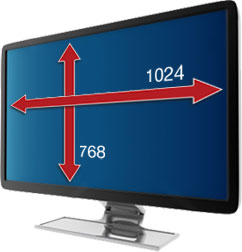 Not all computer users use monitor terminology, but it's worth knowing at least some of the terms used. In general, the size and number of pixels on the screen determine the expected image resolution or image sharpness. Images on a 34-inch screen with a resolution of 800x600 are not as sharp as images on a 17-inch monitor with the same resolution.
Not all computer users use monitor terminology, but it's worth knowing at least some of the terms used. In general, the size and number of pixels on the screen determine the expected image resolution or image sharpness. Images on a 34-inch screen with a resolution of 800x600 are not as sharp as images on a 17-inch monitor with the same resolution.
Also, most computer screens use more pixels in image resolution than many brand TVs, so it's no wonder gamers and movie use monitors for entertainment needs at home. All monitors on this list have impressive image resolutions with high pixel ratios - some are more impressive than others.
Monitor Design
The aesthetics of design are equally important, but we'll discuss their effectiveness here. The new monitor takes up a lot of space on the desk, regardless of whether the screen is curved. This is why you should pay attention to support and the design of its feet.
HDR
The best thing in a gamer life that doesn't need to know why high dynamic range (HDR) is important when playing HDR-shooters and sports games. In fact, if you look at the big difference between images using HDR and images that don't support these technical details, the purchase of a computer screen with HDR capacity is obvious.
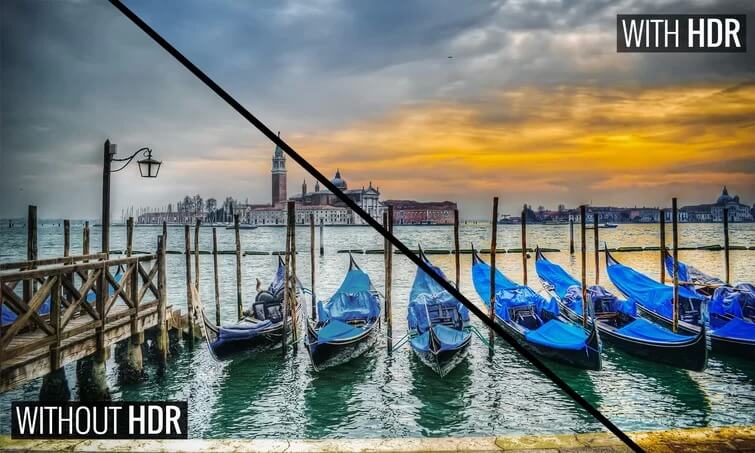
HDR allows you to create a more accurate image of everything the screen tries to display - the zone of images that should be dark remains intact - and the zones that should be brighter are also fully consistent. The monitor model with the only sRGB is great in terms of gamut, but HDR displays that support the Rec2025 gamut are much better.
Refresh Rate
The refresh rate is a measure of the number of times the screen updates an image per second. The rate of the latest monitor scans 60 to 240 and is measured in hertz. This is especially important for gamers. A low refresh rate can cause symptoms commonly known as screen tearing.
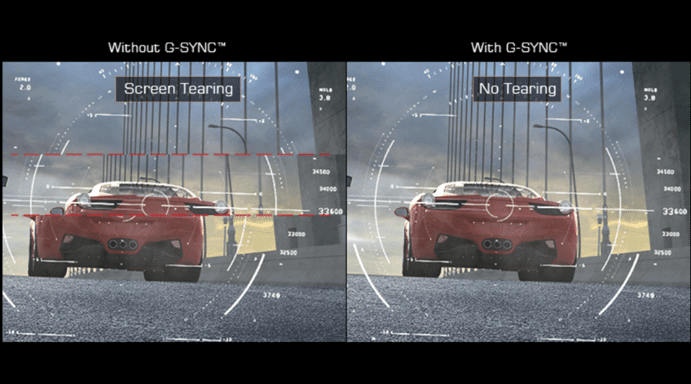
If the GPU sends more images to the monitor than it can process per second, a burst of the screen occurs and two images are generated in a single update. To address this, limit the SPF to the monitor refresh rate or purchase a monitor with a higher refresh rate that is suitable for the SPF. However, if you need to lower the SPF, you can see how this is a problem.
G-sync and free-sync are new monitor-built technologies that reduce the impact of screen corruption.
Response Time
Response time is a measure of the time between changing the monitor's pixels from black to white and returning to black. It can also be measured in GTG (gray to gray). This refers to the speed at which the monitor switches from a gray shade to another.
A millisecond is a standard form of response time measurement, ranging from 8 milliseconds to 1 millisecond. As you probably already understand, shorter response times are much better than long hours.

So how does this affect me as a player? That's a good question.
Longer response times can result in ghost images. In a ghost image, it takes too long to change the pixel, so you can see traces of the moving image. As a gamer who wants to immerse himself in his game completely, Screen Ghost is a real problem because it produces pretty obvious visual flaws.
If you are looking for a good gaming monitor, we strongly recommend that you purchase a screen of 4 milliseconds or less to eliminate nasty and unpleasant visual defects caused by ghost images.
Contrast Ratio
Measures the difference between the whitest whites and the darkest black that the screen can generate. However, most modern monitors have a good contrast ratio, so this feature is for designers only.
Ultra-wide Monitor
Image Ratio - Another common computer display term that monitor buyers should know is image ratio. When talking about image ratios, it refers to the aspect ratio of the display. Overall, the aspect ratio is related to the relationship between the height and width of the monitor in question.
Aspect Ratio
Perhaps, as you already know, the aspect ratio is a proportional measure of the height and width of an image. Monitors have different proportions depending on the shape of the screen, allowing consumers to determine whether the monitor meets their needs.
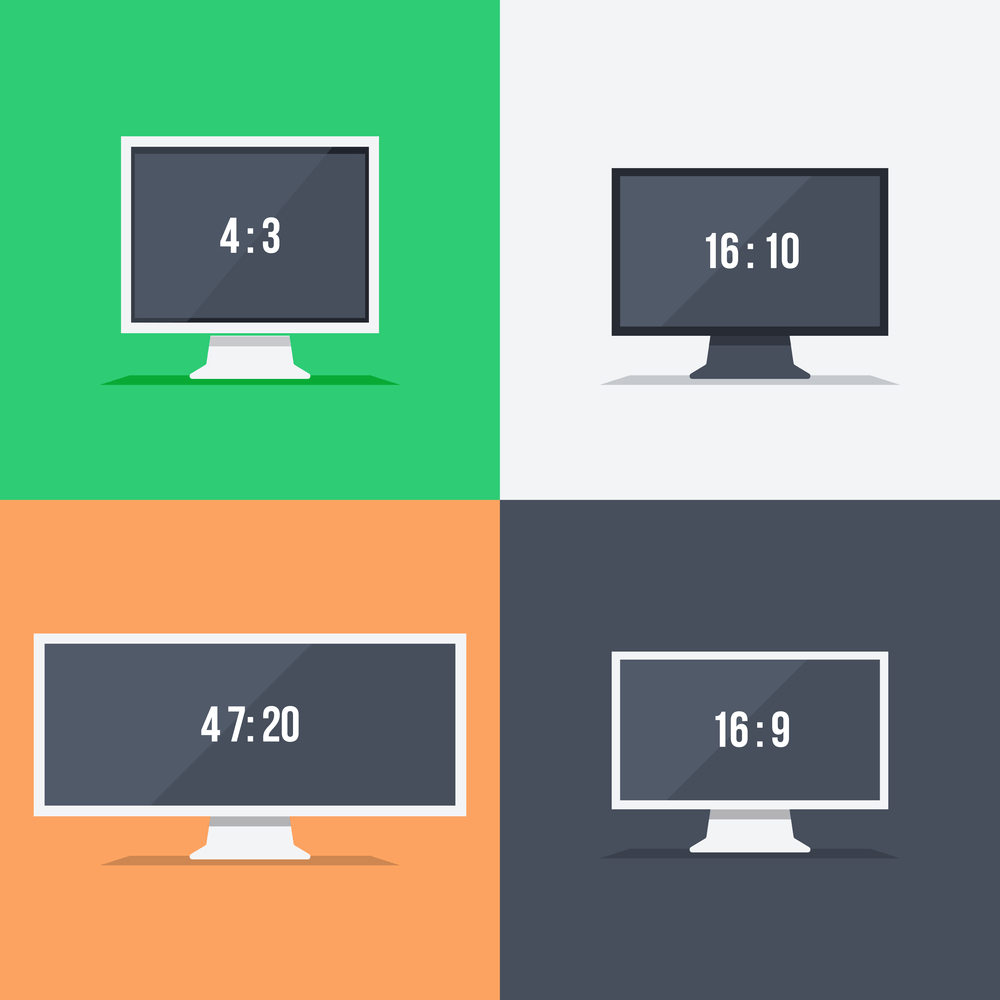
The general ratios are as follows:
- 4:3
- 16:9
- 21:9 (Ultra Wide)
Especially if you buy ultra-widescreen for use as a game monitor, it's worth sure the game you're trying to play can handle a wider aspect ratio. Otherwise, there will be black dead spaces on both sides of the screen, which will damage your visibility.
Many up-to-date game titles support these large ratios but are worth checking before buying.
Cable Management
Like the busiest graphic designers, website creators, game enthusiasts, many cables heading to the back and sides of your computer or screen are confusing recipes.
Even if you don't mind having a lot of cable spaghetti, it's worth remembering the benefits of good cable management. With that in mind, we took the time to propose an ultra-wide monitor that included this important aspect of the computer configuration.
Panel Types
The type of symbol is a bit intimidating, and some people think it's very technical, but it's not. Different panels offer different features and benefits and significantly change the final price of the monitor in question. It also contributes to response time and image clarity.
- The response time of the TN-twisted nematic panel is the shortest, but there is no best image quality or the best viewing angle.
- IPS-In Plan switching panels have easy-to-read angles, solid colors, and generally faster response times than TNs.
- The VA-Vertical Alignment panel is a compromise and is a combination of the two. It is not considered optimal for gaming, but it provides a solid economic choice.
The recommendation when purchasing a game monitor is that IPS provides the best image quality and the best color reproduction. However, if you have a limited budget, there is no problem with the VA or TN sign if you find the right one.
If you want to learn more about panel types, readout our Detailed Guide Here
Curved Monitor
Ask avid gamers about playing action-packed games on a big screen with curved-screens and you'll probably say something like "absolutely awesome guy"! Of course, to be completely immersed in the game, it is not only games-holics but also movie fans who are looking for a cinematic experience that can benefit from a curved display.
The range of options for a curved monitor starts at 34 inches and is more than 43 inches. The resolution also varies considerably - Full HD (1920x1080 pixels), the most common options with the most impressive aspect ratios 16:9 to 21:9, provides higher WQHD (3440x1440 pixels).
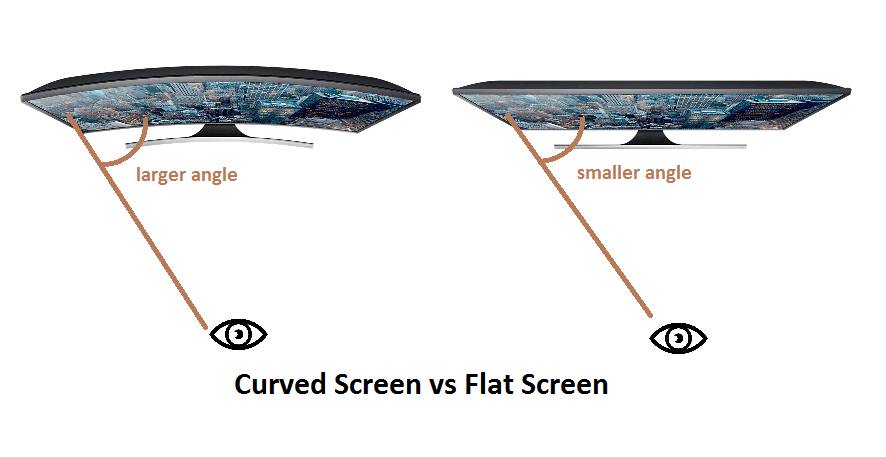
Connectivity
Ultrawide computer screens have a variety of input options. The most common of these is DVI, DisplayPort, and probably the most used of all inputs - HDMI. Of course, don't forget to mention the USB port used to connect computer monitors of any size - according to some of the geekiest computer users, USB Type C is one of the most convenient ones.
Each of these common display input systems should be considered. Pay special attention to each pixel resolution value. Fortunately, the HDMI image resolution (1,920 x 1,080/60) is the same as the DVI or DisplayPort resolution (1,920 x 1,080/60) until the parameters are set. Changed, that is,
Additional Features
Of course, computer users who want to take their own time do everything they can to buy an ultra-large display with all the best components. Finding a large PC monitor with additional features is the right of passionate people how to get the most out of their IT configuration.
It should be noted that some ultrawide screens can run native resolution on today's generation video cards. For players who want to optimize the experience - you can run the game with an existing graphics card without having to worry about upgrading.
FAQs
What Should I Look For In An Ultrawide Monitor?
When looking for an ultrawide monitor, there are several factors to consider. Here are some of the things you should look for:
Aspect Ratio: Ultrawide monitors typically have a 21:9 aspect ratio, which provides a wider field of view than traditional 16:9 monitors. Make sure the aspect ratio fits your needs and preferences.
Screen Size: Ultrawide monitors come in a variety of sizes, from 29 inches to 49 inches. Consider the size of your desk and the distance between your eyes and the monitor to determine what size is best for you.
Resolution: Ultrawide monitors come in different resolutions, including Full HD (1080p), Quad HD (1440p), and Ultra HD (4K). Choose a resolution that matches your computer's graphics card capabilities and your intended use for the monitor.
Refresh Rate: The refresh rate of the monitor is how many times per second the screen refreshes, measured in Hertz (Hz). A higher refresh rate will provide smoother motion and less blur during fast-paced action. 120 Hz and above is recommended for gaming.
Panel Type: The three main types of panels are IPS, VA, and TN. IPS panels have the best color accuracy and viewing angles, while VA panels have the best contrast. TN panels have the fastest response times, making them suitable for gaming.
Curvature: Ultrawide monitors may also be curved, which can provide a more immersive experience and reduce eye strain.
Ports: Make sure the monitor has the necessary ports for your computer and any other devices you plan to connect, such as HDMI, DisplayPort, or USB-C.
Price: Ultrawide monitors can be more expensive than traditional monitors, so make sure to consider your budget when making a decision.
What Is The Best Ultrawide Monitor To Work?
The best ultrawide monitor for work will depend on your specific needs and preferences. Here are some factors to consider when choosing an ultrawide monitor for work:
- Screen size: Ultrawide monitors come in different screen sizes, such as 34-inch, 38-inch, and 49-inch. Consider your workspace and how much screen real estate you need.
- Resolution: Look for a monitor with a high resolution, such as 3440x1440 or 5120x1440, for clear and sharp visuals.
- Refresh rate: For work purposes, a 60Hz refresh rate should be sufficient. Higher refresh rates are more important for gaming.
- Connectivity: Make sure the monitor has enough connectivity options for your needs, such as HDMI, DisplayPort, and USB.
- Ergonomics: Look for a monitor with adjustable height, tilt, and swivel to ensure a comfortable viewing position.
Some of the best ultrawide monitors for work include the LG 34WK95U-W, Dell UltraSharp U3419W, and Samsung CJ791.
What Is The Best Ultrawide Aspect Ratio?
The best ultrawide aspect ratio for you will depend on your specific needs and preferences. The most common ultrawide aspect ratios are 21:9 and 32:9. A 21:9 aspect ratio ultrawide monitor provides a wider field of view than a standard 16:9 monitor, which can be useful for multitasking or creative work that requires more screen real estate. A 32:9 aspect ratio ultrawide monitor is even wider, providing an even more immersive experience, but may not be ideal for all use cases.
In general, a 21:9 ultrawide monitor is a good compromise between a standard monitor and a 32:9 ultrawide, offering a good balance between screen space and usability. However, if you work with a lot of data or frequently use multiple applications simultaneously, a 32:9 ultrawide may be a better choice.
Which Is Better Ultrawide Ips Or Va Panel?
Both IPS and VA panel ultrawide monitors have their advantages and disadvantages, so it ultimately depends on your needs and preferences.
IPS (In-Plane Switching) panels generally offer better color accuracy, wider viewing angles, and faster response times than VA (Vertical Alignment) panels. This makes them a good choice for tasks that require color accuracy, such as photo and video editing. However, IPS panels typically have lower contrast ratios than VA panels, which means that blacks may not appear as deep and colors may not appear as vibrant.
On the other hand, VA panels have higher contrast ratios than IPS panels, which makes them a good choice for tasks that require deep blacks, such as gaming or watching movies. They also typically have better black uniformity than IPS panels, which means that dark scenes will appear more consistent across the screen. However, VA panels may suffer from color distortion when viewed at off-angles, which may be a concern if you often work with others who need to view your monitor.
Are 34 Inches Too Big For A Monitor?
The optimal size for a monitor depends on several factors, such as your viewing distance, usage, and personal preferences. A 34-inch monitor may be too big for some people, while it may be just right for others.
If you're using the monitor for productivity work or multitasking, a larger screen may help you see more information at once, reducing the need for scrolling or switching between applications. However, if you have limited desk space or prefer a more compact setup, a smaller monitor may be a better fit.
For gaming and entertainment, a larger monitor can provide a more immersive experience, especially if it has a high resolution and refresh rate. However, if you're sitting too close to the screen, a large display may be overwhelming and strain your eyes.
Ultimately, the ideal size for a monitor is subjective, and it depends on your specific needs and preferences. If possible, you may want to try out different sizes and see which one feels the most comfortable and efficient for you.
Is Ultrawide Or 4k More Productive?
Both ultrawide and 4K monitors can increase productivity in different ways, depending on the type of work you do.
Ultrawide monitors typically have an aspect ratio of 21:9 or wider, which means they provide a wider viewing area than standard 16:9 monitors. This can be beneficial for productivity work that involves multitasking or working with multiple windows side by side. With an ultrawide monitor, you can have more applications open and visible at once without having to switch between them or resize windows constantly.
On the other hand, 4K monitors offer a higher resolution than standard Full HD monitors, providing more screen real estate and sharper, more detailed images. This can be especially useful for tasks that require precise detail, such as photo and video editing or graphic design. With a 4K monitor, you can see more of your work at once and make more accurate edits without having to zoom in and out constantly.
Ultimately, the choice between an ultrawide or a 4K monitor depends on your specific needs and preferences. If you tend to multitask and need a wide viewing area, an ultrawide monitor may be more productive for you. If you work with high-resolution images or need to see more detail, a 4K monitor may be a better choice.
Is Ultrawide Good For Eyes?
Ultrawide monitors can be good for your eyes in some ways, but there are also some potential drawbacks to consider.
On the positive side, ultrawide monitors can reduce eye strain by providing a wider viewing area and reducing the need to switch between applications or resize windows constantly. This can be especially beneficial if you tend to work with multiple applications or documents at once.
Ultrawide monitors can also reduce the need for excessive scrolling, which can be beneficial for people who suffer from neck or shoulder pain.
However, there are also some potential drawbacks to using an ultrawide monitor. For example, if you sit too close to the screen or the monitor is too large, it can cause eye strain and discomfort. Additionally, some people may find it challenging to adjust to the wider aspect ratio of an ultrawide monitor and may experience visual distortion or dizziness.
Overall, ultrawide monitors can be good for your eyes if used correctly and in moderation. It's essential to choose a monitor with a size and aspect ratio that suits your needs and to maintain a comfortable viewing distance to avoid eye strain and discomfort. Additionally, taking regular breaks to rest your eyes can help reduce the risk of eye fatigue and strain.
Is It Better Than Va?
Ultrawide monitors and VA (Vertical Alignment) monitors are two different types of technologies, so it's not a direct comparison between them. Ultrawide monitors refer to the aspect ratio and screen size, while VA is a type of panel technology used in monitors.
VA panels are known for their high contrast ratios and good color accuracy, making them popular among gamers and graphic designers. They offer better viewing angles than TN (Twisted Nematic) panels but are generally slower in terms of response time, which can result in motion blur or ghosting.
Ultrawide monitors, on the other hand, offer a wider aspect ratio that can be beneficial for productivity work and multitasking. They can also be used for gaming and entertainment, providing a more immersive experience than standard 16:9 monitors. However, ultrawide monitors can be more expensive and require more graphics processing power than standard monitors.
In summary, ultrawide monitors and VA panels are two different technologies that serve different purposes. If you're looking for a monitor primarily for gaming or graphic design, a VA panel may be a better choice. If you need a wider viewing area for productivity work, an ultrawide monitor may be more suitable. Ultimately, the best choice depends on your specific needs and preferences.
Should I Buy Ultrawide Monitor Or a Normal Monitor?
Whether you should buy an ultrawide monitor or a normal monitor depends on your specific needs and preferences.
If you need a wider viewing area for productivity work or multitasking, an ultrawide monitor may be a better choice. With an ultrawide monitor, you can have multiple windows open and visible at once without having to switch between them or resize windows constantly. This can be especially beneficial for tasks such as video editing, programming, or data analysis, where you need to have multiple applications open simultaneously.
On the other hand, if you're looking for a monitor primarily for gaming or entertainment, a normal monitor may be a better choice. While ultrawide monitors can provide a more immersive experience for gaming and entertainment, they can also be more expensive and require more graphics processing power than normal monitors.
Additionally, if you have limited desk space or prefer a more compact setup, a normal monitor may be more suitable. Ultrawide monitors can take up more desk space and may not fit in all workspace configurations.
Conclusion
Well, This was all about Best Ultrawide Budget Monitor. I hope you like my in-depth & researched-based reviews & guide. Feel free to post your comment below.
Top-Rated Ultrawide Budget Monitor 2025
Also Read:
- PC Gaming vs Console Gaming | Which One is Best
- 18 Things To Do With Old Computers That Still Work
- IPS vs TN For Gaming | Which one is best [Solved]
- Difference Between UHD and 4k
